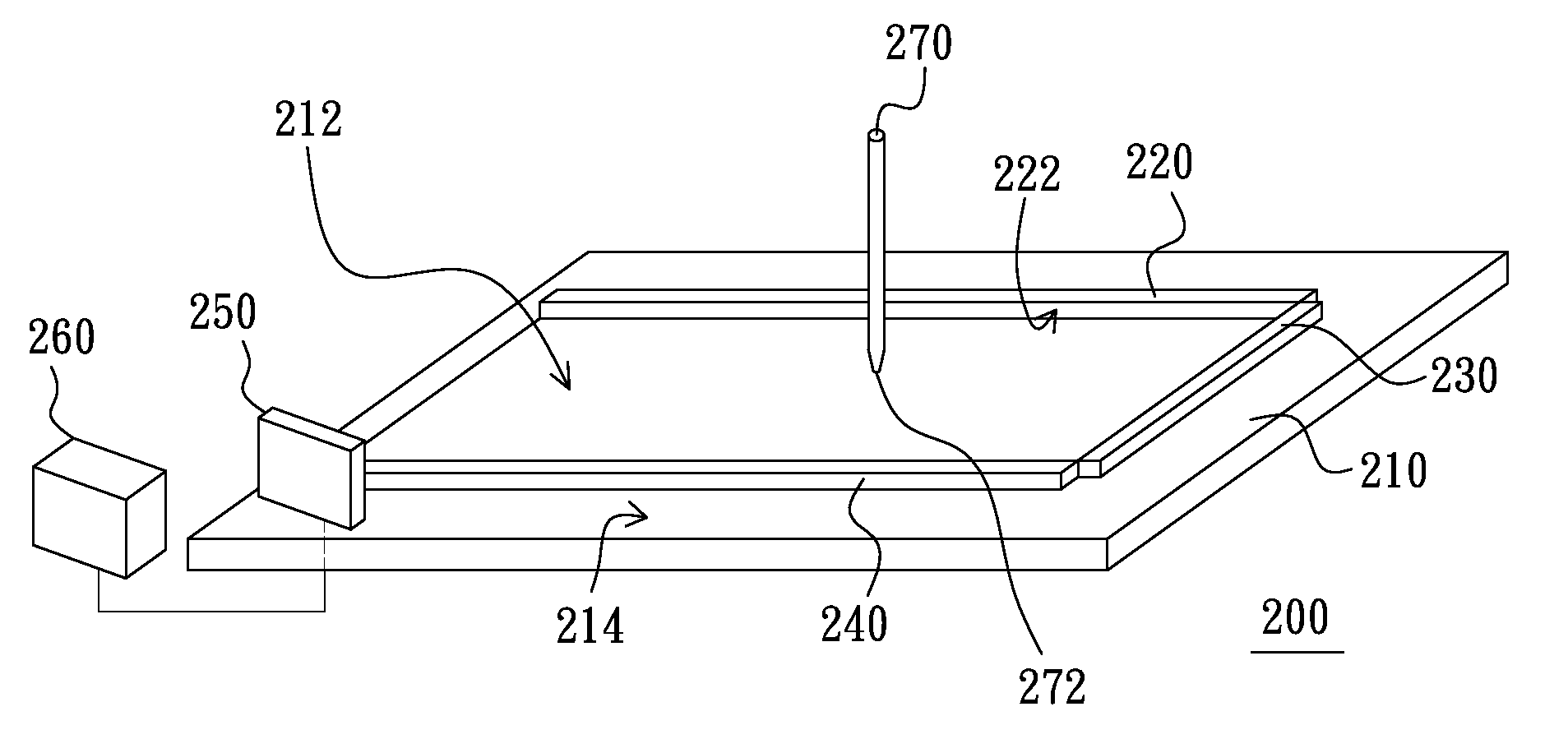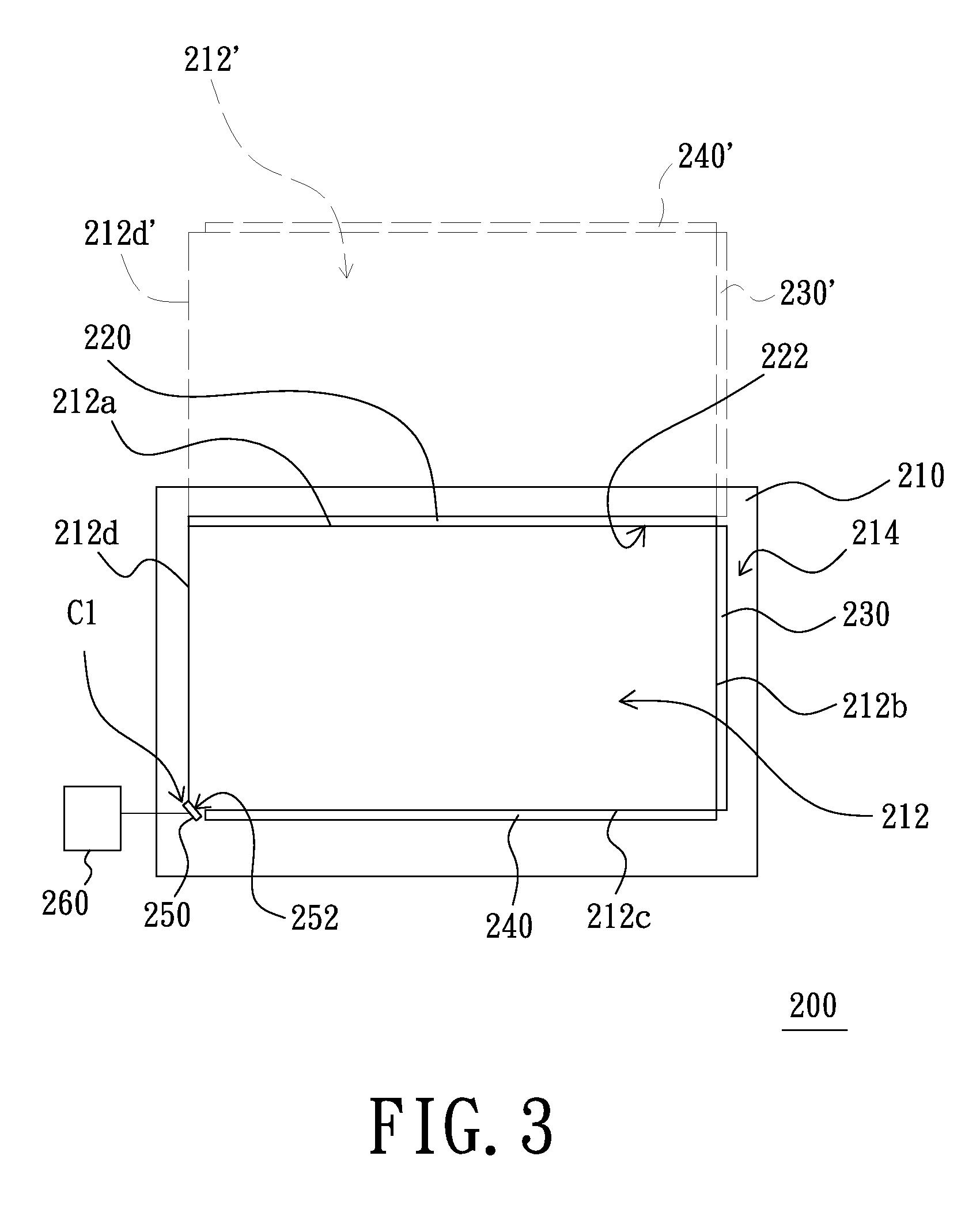Sensing system
a technology of sensing system and touch system, which is applied in the field of sensing system, can solve the problems of relatively high production cost of each of the touch system disclosed in the patents, and achieve the effect of low production cos
- Summary
- Abstract
- Description
- Claims
- Application Information
AI Technical Summary
Benefits of technology
Problems solved by technology
Method used
Image
Examples
first embodiment
[0033]FIG. 2 is a schematic three-dimensional view of a sensing system of a first embodiment of the present invention. FIG. 3 is a schematic top view of the sensing system of FIG. 2 in operation. Referring to FIGS. 2 and 3, the sensing system 200 is adapted to sense a pointer 270 and calculates the location of the pointer 270 (please see the following detailed description). The sensing system 200 includes a panel 210, a reflective element 220, a first linear light source 230, a second linear light source 240, an image sensor 250 and a processor 260. The panel 210, for example, a whiteboard or a touch screen, have a first plane 214 and a first area 212 located at the first plane 214. The first area 212 is quadrangular, such as a rectangle. Furthermore, the first area 212 has a first boundary 212a, a second boundary 212b, a third boundary 212c and a fourth boundary 212d which are connected in order.
[0034]The reflective element220 is disposed at the first boundary 212a and located on t...
second embodiment
[0043]FIG. 6 is a schematic top view of a sensing system in operation of a second embodiment of the present invention. FIG. 7 is a schematic view showing that the processor of FIG. 6 calculates the location of the pointer. Referring to FIGS. 6 and 7, the difference between the sensing system 300 of the present embodiment and the sensing system 200 of the first embodiment lies in that the present sensing system 300 further includes a third linear light source 390 and that the first area 312 located at the first plane 314 of the panel 310 is quadrangular and not a rectangle.
[0044]The third linear light source 390 is disposed at the fourth boundary 312d of the first area 312, and the third linear light source 390 is mirrored by the reflective element 320 to form a fourth mirror image 390′. The reflective element 320 disposed at the first boundary 312a of the first area 312, the first linear light source 330 disposed at the second boundary 312b of the first area 312, the second linear l...
third embodiment
[0052]FIG. 10 is a schematic three-dimensional view of a sensing system of a third embodiment of the present invention. Referring to FIGS. 2 and 10, the difference between the sensing system 400 and the sensing system 200 lies in that the first linear light source 230 and the second linear light source 240 are omitted in the sensing system 400. The sensing system 400 includes a first light source 430 located above the first plane 414 of the panel 410 and outside the first area 412. The first light source 430 is mirrored by the reflective element 420 to form a second mirror image 430′. The first light source 430 and the second mirror image 430′ are located outside the sensing range of the image sensor 450. The pointer 470 has a reflective surface 472 which may be coated by a reflective material. The reflective material of the reflective surface 472 meets the Europe Standard of EN471 but is not limited in this.
[0053]The first light source 430 is adapted to emit invisible light, such a...
PUM
 Login to View More
Login to View More Abstract
Description
Claims
Application Information
 Login to View More
Login to View More - R&D
- Intellectual Property
- Life Sciences
- Materials
- Tech Scout
- Unparalleled Data Quality
- Higher Quality Content
- 60% Fewer Hallucinations
Browse by: Latest US Patents, China's latest patents, Technical Efficacy Thesaurus, Application Domain, Technology Topic, Popular Technical Reports.
© 2025 PatSnap. All rights reserved.Legal|Privacy policy|Modern Slavery Act Transparency Statement|Sitemap|About US| Contact US: help@patsnap.com



